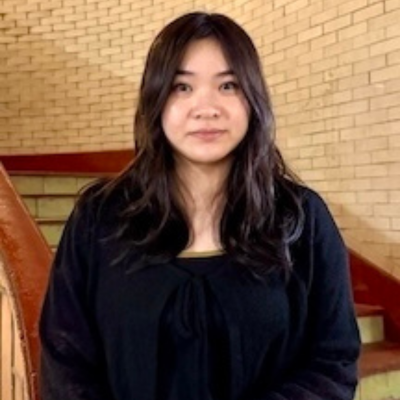 Ke-Li Chen
Ke-Li Chen
Which Comes First? The Temporal Order of Reward Sensitivity and Inflammation Following Childhood Abuse
Advisor: Phoebe Lamb
Major: Psychology
Additional Major: Biological Sciences
Abstract
Causal perception is the ability to identify the agent and recipient in a physical event (e.g. when one pool ball hits another). An ongoing study that tests whether infants attend to the shape, color, or rotation of an agent suggests that nine-month-old babies encode the color of an agent in a causal event, where as 13-month-olds encode the shape and orientation of the agent but not its color. To expand on the ongoing study, the experiment proposed here will test the same age groups to determine what animate surface features of the agents infants encode. In this study, infants will be shown a series of causal events where the agent possesses eyes, a mouth, and a pair of hands. In each of a series of test trials, each of these animate surface features will be replaced with a different feature. Looking times will be analyzed to determine which animated surface features babies attend to.
Bio
I was tethered to a chair in the dining room, my lips sealed with duct tape. Fresh bruises purpled my shins. If I flinched again, he'd kill me.
That's what would happen if I tried to run again, he warned me. If a tear couldn't escape, then I certainly couldn't either.
I looked frantically around the room. My little brother was crying. My mom's eyes were glazed and empty. She was being abused too, and had no idea how to get us out.
The day we finally filed a restraining order against my father and changed the locks, a weight was lifted — despite having hardly noticed I was bearing it to begin with. That night, over dinner, I purposely sat in the same chair where I'd once been trapped. We told jokes and laughed. Our home came alive. Finally, we were free.
Despite this being a true freedom my family had never known, it oddly felt like not much had changed. The journey towards healing and accepting this new reality seemed to occur in nearly intangible steps. Like a renaissance, we were able to breathe in new and invigoratingly light air, but forward progression began to incur realizations that felt like learning to walk in a world that expected us to have been running marathons. Suddenly, impacts of the abuse I'd experienced began to show themselves, but it hadn't always been clear that obstacles I was forced to overcome had been rooted in the abuse. I had to realize that minor decisions like what shoes to wear likely weren't life or death choices. Making mistakes without persistent fear of imagined harm was a brand new experience. Believing in my ability to do valuable work, take up space and truly feel the good and happy things in life required effort that was frustrating when I imagined the nonexistent reality where I had the opportunity to learn and believe all these things from a younger age.
In the weeks, and ultimately years, to come, I thought about why I chose to sit in the same chair that night despite experiencing over a decade of abuse in it. I think, in part, I needed to reclaim it. To make it part of a story I was now getting to write myself. But I also saw in that chair a space to take up. I felt like I'd earned that seat at the table. And I'm determined to use that chair for good with reverberating impact.
In the years since pushing my abuser out of the house, I've come to understand that there are extremely wide-ranging implications of abuse. In learning from other survivors of abuse, discussions around abuse often being considered a private matter, survivors facing blame from external parties, and how to address the cyclic nature of abuse and generational trauma have been at the forefront of the community. Implications of abuse extend much farther than I expected based on my prior knowledge and expectations. This has led to a passion for understanding the various implications of abuse and contributing to faciliating informed conversations about abuse to encourage a society more empathetic to the lasting consequences of experiencing abuse. I especialy aspire to reduce victim-blaming and stigma around survivors' behavior by elucidating the underlying mechanisms of risky health behavior and reactions over time — ultimately encouraging public realization that health-compromising behaviors may have biological underpinnings rather than being mere lifestyle choices.
There was a time when all I knew were locked doors, foreboding footsteps and a seat at a table where I was never welcomed. Now, as I open my own doors, take empowered steps forward and take my place at tables I never even knew could exist for me, I hope to contribute to furthering knowledge on the impacts of abuse and the underlying mechanisms to ultimately aid in supporting survivors and stopping the cycle of abuse that continues to permeate our society.